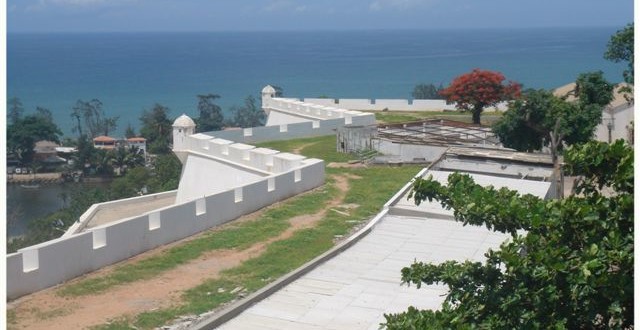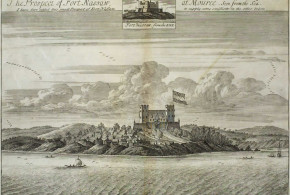Written by Marco Ramerini. English text revision by Dietrich Köster.
If you know something on colonial remains or if you have photos of such remains – they may be anywhere in the world -, send them to me. I’ll be happy to publish them on this website. Thank you. Marco. My e-mail is on the home page.
PORTUGUESE COLONIAL REMAINS
AFRICA
ANGOLA
Creole community, Portuguese language, Portuguese surnames, religion.
Mbanza Kongo: Ruins of São do Salvador do Congo with the ruins of the Church of the Sé. M’banza Kongo was the capital of the Kingdom of Kongo. Actually M’banza Kongo still contains an important number of buildings, which date back to the 16th Century such as: the old Cathedral Ruins; the residence of the kings of the Kongo, where is now the Museum of the Kongo Kingdom; the king’s tomb.
Ngonga Mbata: foundation remains of the Church. Ielala: Stone Inscription (1485) on the shore of the River Congo.
Mouth of the River Congo: stone “padrão” of São Jorge ?.
Luanda: Fortress of S. Miguel de Luanda (1575) (this fortress is well preserved), Fortress of São Pedro da Barra (17th-18th c.) (it is badly preserved), ruins of Fort São Francisco do Penedo (17th-18th c.) (it’s badly preserved), Chapel of the Morro da Cruz, a few buildings in the Rua dos Mercadores, Church of Nossa Senhora do Cabo, Church of Nossa Senhora dos Remédios, Church of Jesus, Church of Carmo, Church of Nossa Senhora da Nazarè, Igreja da Misericórdia, Customs-House.
Muxima: Fort (17th century) (it is badly preserved) and Church of Nossa Senhora da Conceiçào da Muxima (it is in relatively good order).
Massangano: Fort (16th-17th c.) and Church of Nossa Senhora da Vitória.
Kambambe: Fort (17th c.) (it’s badly preserved) and Church of Nossa Senhora do Rosario (it’s badly preserved).
Encoge: Fort S. Jose de Encoje (18th c.).
Kikombo (Quicombo): Fort (17th c.) few remains (it’s relatively in good order).
Bembe: Fort.
Benguela: Igreja de Nossa Senhora do Pópulo, Palácio Velho.
BENIN
Ouidah: Fort of São João Baptista de Ajudá (1680), Church ?.
Porto Novo: Portuguese church
CAPE VERDE ISLANDS
Creole community, Portuguese language, Portuguese Creole language, Portuguese surnames, religion.
Santiago Island: Ruins of Cidade Velha de Ribeira Grande: Forte de São Filipe, Filipe, Cathedral, Igreja de São João Baptista.
EQUATORIAL GUINEA
Portuguese Creole language (Annobon Island), Portuguese surnames …
Ayene: Portuguese fort ?
ETHIOPIA
Gondar: Portuguese influences in many castles.
Gorgorà: Ruins of Maryam Ghemb Castle’s, built by the Jesuit Pero Pais (1619-1621).
Fercaber (Lake Tana): Portuguese Bridge (Km 50 road Gondar-Debra Tabor).
GHANA
Axim: Fort Santo António (1515).
Elmina: Forte São Jorge (1482).
GUINEA BISSAU
Creole community, Portuguese language, Portuguese Creole language, Portuguese surnames …
Bambaya: Fort ruins.
Bissau: Forte São José de Amura (1696).
Bolama: Fort ruins.
Cacheu: Fort and Church (17th c.).
KENYA
Malindi: Padrão (1498), foundations’ remains of Feitoria and Residence of Portuguese Captains, Chapel.
Mombasa: Fort Jesus (historical monument) (1593).
Dondo (near Lamu Island): Remains of the ground floors of a Portuguese House.
MADAGASCAR
Tolanaro: Remains of a Portuguese Fort.
MOROCCO
Alcacer Seguer /Al Qasr Sayeer: The walls surrounding the town, towers and the Sea-Gate. Ruined buildings inside the fortified city.
For this info my thanks to Kiros Kokkas.
Arzila /Asila (also Arcila or Asilah): The city walls and the rampants (perfect condition). The Porta da Terra has the Portuguese coat of arms over the entrance.
For this info my thanks to Kiros Kokkas.
Larache: The 16th century walls near the port in the lower part of the city. Azemour: The walls surrounding the city.
For this info my thanks to Kiros Kokkas.
Mazagão/Al Jedida: Enormous city walls with ramparts, bastions and towers in a very good condition, huge gates (Porta do Mar, Porta da Terra, Porta dos Bois). The church of the Assumption near the Porta da Terra. An underground cistern (Cisterne portugaise).
For this info my thanks to Kiros Kokkas.
Safim/ Safi: The Fort by the sea (Castelo do Mar). The remains of the Portuguese Cathedral (unfinished) turned to hammam, now a museum.
For this info my thanks to Kiros Kokkas.
Mogador /Essaouira: Huge city walls and ramparts. Bastions of Skala de la Ville and Skala du Port with many Portuguese cannons. Fortifications on the rocky Ilha de Mogador, opposite the harbour.
For this info my thanks to Kiros Kokkas.
My nephews told me about 2 mountans that we saw while we where hiking near Agouins, Ouarzazate province. The mountains are called Tikniwin which translates to twins. These mountains appear to be have so sort of base for the Portuguese a couple hundred years ago.
For this info my thanks to Abdellah Id Abdellah.
Tanger:
Azamor:
Aguz: ruins of the “castelo de Aguz” (1507-8)
MOZAMBIQUE
Creole community, Portuguese language, Portuguese surnames, religion.
Ilha de Moçambique: is an UNESCO World Heritage site, Historical Town; Fortress of São Sebastião (1558), Church of Nossa Senhora do Baluarte (1522), Church of Misericórdia, Palace of São Paulo (convent of Jesuits) (18th c.), Chapel of São Paulo, Forte and Igreja de Santo António, Forte de São Gabriel, Forte de São Lourenço, Convento de São Domingo (1662), Igreja da Saúde.
Mossuril: old mission ruins.
Ibo: Historical Town, church of Nossa Senhora do Rosário (1580), Forte de São Jose, Forte de São João Baptista (1791), Forte de Santo António, old buildings.
Sofala: The few ruins of the fort are submerged during high-tide.
Tete: Fort Sao Tiago Maior (1575/6)
Maputo: Forte Nossa Senhora da Conceição (1799).
SÃO TOMÉ AND PRÍNCIPE
Creole community, Portuguese language, Portuguese Creole language, Portuguese surnames, religion.
São Tomé Island: Forte São Sebastião, Fort São Jerónimo (1700), Igreja da Madre de Deus, Igreja do Bom Despacho, Rocas.
Príncipe Island: Forte de Santo António da Ponta da Mina (ruins) (17th c.), Rocas.
SENEGAL
Portuguese Creole language (Ziguinchor Casamance), Portuguese surnames.
Portudal (Porte de Aly): Fort remains
Ziguinchor: Portuguese chapel, ex-maison Maurel et Prom, ex-Hôtel de Ville.
SPANISH AFRICA
Ceuta/Sabta: Foso de San Felipe (San Felipe Moat) and the Muralla Real (the Royal Wall). The church of Nossa Senhora da Africa, originally commissioned by Dom Henrique the Navigator. Besides, in the neaclassical Cathedral there is the Imagen de Nuestra Señora de África, XVth century Virgin Mary’s Portuguese image, that is the city’s religious Patron and receives honours honours like a Capitán General. Furthermore, the original Banner of the city, which is Portugal’s Coat of Arms, was embroidered by Portuguese Queen Dona Filipa.
For this info my thanks to Antonio Vazquez and Kiros Kokkas.
Canary Islands: In the Canary Islands the Portuguese influence is still felt in the indigenous vocabulary, which has linguistic terms of Portuguese origin especially related to field work and the cavaquinho, a musical instrument, here known as timple.
For this info my thanks to Fernando Velho Toulson.
TANZANIA
Kilwa Kisiwani: Ruins of Forte Santiago (a Portuguese multi-angular bastion on the northeast side), its condition is poor. In this century the coastline has retreated, thus undercutting the foundations the massive masonry of the fort. The eastern towers and walls have fallen into the Indian Ocean and sand fills the remaining ruins. Vandalism and uncontrolled plant growth are further undermining the once powerful site. The situation needs to be investigated in detail, in order to evaluate the possibility of saving this monument. Without urgent technical assistance its loss is imminent. The Portuguese fort of Kilwa Kisiwani is on the Unesco World Heritage list (in danger).
Zanzibar Island: Fort (the castle was built on the site of an old Portuguese church (1550s) (hence its local name “Gereza” fort), but as it was built by the Omani Arabs, who ruled in Zanzibar nothing from the old church was left). Three cannons carrying the monograms of Kings Manuel and João III (16th century) are said to have been captured by Persian forces during the siege of Hormuz in 1622. In the southern part of the Stone Town of Zanzibar between the neighbourhoods of Shangani and Vuga at the sharp corner of the crossing of the Kanuda Road with the Vuga Road stands a beautiful (and perfectly preserved) stone arch, which in all town maps is invariably referred to as the “Portuguese Arch” and has typical Portuguese decorative elements (no construction date, it could be original Portuguese or made later in the Portuguese style).
For this info my thanks to Kiros Kokkas (Sept 2006).
Mulveni (Pemba Island): Remains of two Portuguese houses.
ZIMBABWE
My thanks to Chris Dunbar (Feb. 2009) for the following informations:
In the northeast of the country near the border with Mozambique there are the remains of a Portuguese fort, which was used in the 1600s.
These are sites. which were investigated and catalogued by the Rhodesian Government, no Portuguese sites have been restored (unfortunately) and no more have been added since the first cataloguing was done in the early 1970s. Following are the site names and the Department’s internal national monuments’ identification:
Chipfuka 1629 BC 8
Pirigani 1630 CC 5
Chesa Farm 1631 DC 34
Guzha Farm 1631 DC 38
Guzha Farm 1631 DC 39
Murewa farm 1631 DC 40
Chemapere 1631 DC 41
Bhasikiti 1631 DC 42
Kapfira 1631 DC 43
Mandishora Farm 1631 DC 46
Umfurudzi 1631 DD 17
Umfurudzi 1631 DD 18
Chipunza 1631 DD 19
Muchekayawa 1631 DD 20
Chiweshe 1631 DD 21
Chikohora 1631 DD 22
Zvipfuko 1631 DD 23
Chitomba 1632 DC 1
Angwa Fort 3 1729 BB 1
Angwa Fort 1 1729 BB 2
Angwa Fort 4 1729 BB 3
Angwa Fort 5 1729 BB 4
Angwa Fort 2 1729 BB 5
Two Tree Hill Estate 1729 BB 19
Dambarare – Doxford 1730 BD 2
Flowing Bowl Mine 1730 BD 4
Dambarare 1730 BD 18
Dambarare 1730 BD 19
Dambarare 1730 BD 20
Dambarare 1730 BD 21
Dambarare 1730 BD 22
Dambarare 1730 BD 23
Doxford 1730 BD 27
Doxford 1730 BD 32
Pentland Farm 1730 BD 33
Quitamboruidzi
Tafuna
Luanze 1732 BA 1
Makaha 1732 BC 1
Maramuca 1829 BB 2
Shigodora (Chipangura) 1932 BA 19
 Colonial Voyage The website dedicated to the Colonial History
Colonial Voyage The website dedicated to the Colonial History






































































